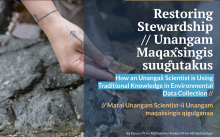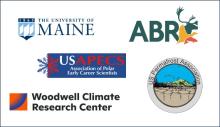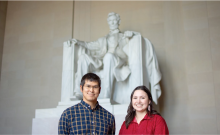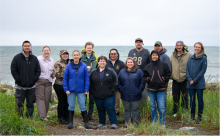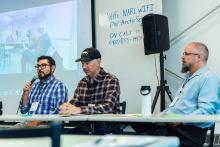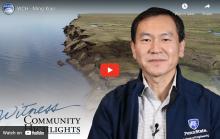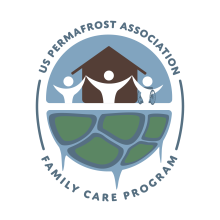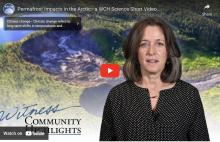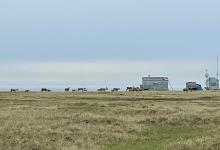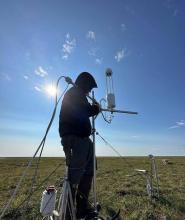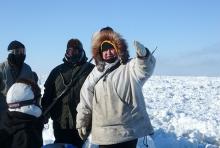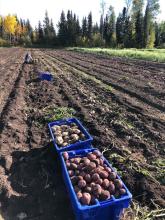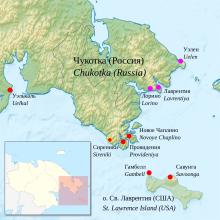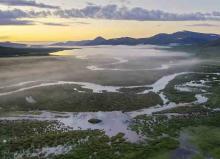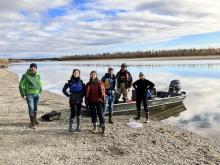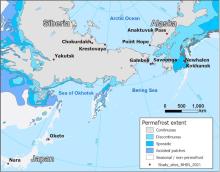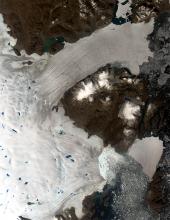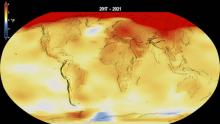Witness Community Highlights is an online publication launched in May 2017 to complement the regular publications of Witness the Arctic. It was developed in response to community feedback identifying the need for a monthly publication to highlight 1–2 Arctic research efforts and other timely items of interest to our readers. Community Highlights is distributed monthly via our Witness the Arctic mailing list of over 8,600 subscribers.
Restoring Stewardship: How an Unangax̂ Scientist is Using Traditional Knowledge in Environmental Data Collection
This issue of Witness Community Highlights features a compelling piece by Kanesia McGlashan-Price, an Unangax̂ multimedia creator. In her interview with Shayla Alamax̂ Shaishnikoff, an Unangax̂ scientist, Kanesia explores how Shayla is integrating Traditional Ecological Knowledge (TEK), or Indigenous Knowledge, into her groundbreaking research on blue mussels.
Arctic Community Highlight Video: Cody Johnson, UIC Science
This issue of Witness Community Highlights includes our latest Arctic Community Highlight video spotlighting Cody Johnson, Director of Operations at UIC Science. These Highlight videos showcase the research of the individual and their organization, while also providing personal insights into their professional journey.
Spotlight on ARCUS Members: Arctic Community Highlight Videos
This issue of Witness Community Highlights includes a series of video highlights featuring leaders from ARCUS institutional members. Our latest videos spotlight Dr. Kristin Schild, Assistant Professor at the University of Maine; Dr. Gerald "J.J." V. Frost, Senior Scientist at ABR Inc.; and Dr. Meghan Helmberger, Board Co-Chair of the U.S. Association of Polar Early Career Scientists. We also invite you to revisit two previously released features: Dr. Sue Natali of the Woodwell Climate Research Center and Dr. Ming Xiao, Board President of the U.S. Permafrost Association.
Arctic Indigenous Scholars Bring Perspectives on Resource Management and Community Wellness to Washington, DC - Interviews with the Scholars
Arctic Indigenous Scholars Craig Chythlook and Taniesha Moses traveled to Washington, DC from March 4-8, 2024 to engage with decision-makers and policy-makers. This Witness Community Highlights piece showcases video interviews with the Scholars, offering insights into their experiences and discussions during the visit.
Sea Ice for Walrus Outlook Partners Gather in Nome
The Sea Ice for Walrus Outlook (SIWO) is a resource for Alaska Native subsistence hunters, coastal communities, and others interested in sea ice and walruses. The Outlooks are produced with information on weather and sea-ice conditions provided by Alaska Native sea-ice experts, NOAA’s National Weather Service-Alaska Region (NWS), and the Alaska Ocean Observing System (AOOS).
SIWO Partners met in Nome, Alaska for a two-day workshop in July 2024. The goals of the meeting were to: (1) Create an opportunity for SIWO partners to meet in person, strengthen relationships, and create a shared vision for SIWO; and (2) Outline a SIWO synthesis paper & a community outreach product to share lessons from 15 years of SIWO.
Permafrost and Infrastructure Symposium: Merging Science, Engineering, and Community-Based Knowledge
In August 2023, the NSF-funded Permafrost and Infrastructure Symposium convened at the Barrow Arctic Research Center with over 30 visiting scientists and engineers, 15 North Slope residents, and three international participants. By planning a single event with participants from multiple science projects, Symposium organizers sought to enhance information sharing and synergies between projects while reducing the demands of outreach and engagement on local communities and research partners. NSF strategic objectives of the Symposium included rapid dissemination of results and promoting impact-driven and use-inspired research.
By: Jana Peirce, University of Alaska Fairbanks (UAF); Benjamin Jones, UAF; Vladimir Romanovsky, UAF; and Billy Connor, UAF.
Get Involved: Collaboration to Support Arctic Research
Based on the achievements and ongoing efforts outlined in the 2022–2024 IARPC Implementation Plan, IARPC is now soliciting input from all sectors on the next set of research challenges and new priorities for the years 2025–2026. The community is invited to share thoughts and perspectives, on the IARPC-hosted form through Friday, 31 May 2024.
By: Larry Hinzman, Interagency Arctic Research Policy Committee, Executive Director
Collaborative Work on Impacts of Permafrost on Civil Infrastructure
In this Witness Community Highlights video feature, Ming Xiao, Professor of Civil and Environmental Engineering at Penn State University, shares insights from his research to better understand changes in permafrost and the related impacts on civil infrastructure. He also highlights the value of collaboration with investigators across academic disciplines, industry sectors, and agencies at the local, state, and federal levels—to understand this complex system.
US Permafrost Association Launches Family Care Program
The US Permafrost Association (USPA) is launching the Family Care Program that will provide resources, events (such as an upcoming panel discussion on balancing childcare and work responsibilities in permafrost research), and funding. Funds are open to USPA members doing permafrost-related work at any career stage and can be used to alleviate the burdens of additional expenses for caregivers to conduct travel-related work activities such as fieldwork and attending conferences.
Permafrost Impacts in the Arctic—a WCH Science Short Video
In this Witness Community Highlights video feature Sue Natali, Project Lead for Permafrost Pathways and Senior Scientist at Woodwell Climate Research Center, shares insights from the work she and her team do on local-to-global impacts of climate change with a focus on permafrost thaw in the Arctic and related community adaptation efforts. She also shares her personal experience communicating science to the public.
Assessing Ice Wedge Micro-Topography Interactions with Environmental Parameters in Alaska through Family Friendly Science
Winter thermal contraction cracking and subsequent spring meltwater infiltration produce the ice wedge polygons prevalent in Arctic terrestrial permafrost systems. Point measurements of physical characteristics and carbon dioxide and methane fluxes in low- and high-centered ice wedge polygon sites enable a better understanding of micro-topography ecosystem processes and of the environmental responses to degrading permafrost.
By Melissa Ward Jones, Institute of Northern Engineering, University of Alaska Fairbanks
Understanding the Long-term Changes in the Arctic Carbon Balance
The NSF supported research group at San Diego State University has used eddy covariance to track Arctic carbon and methane fluxes to gain knowledge of the multi-decadal patterns in these green house gas fluxes. This knowlege is critical to understanding the response to climate variability and long-term change in the carbon balance in the Arctic. Among their findings is that earlier snowmelt is associated with more tundra net carbon sequestration and higher plant productivity only in June and July, but with lower net carbon sequestration and lower plant productivity in August.
By: Donatella Zona, San Diego State University (SDSU) Kyle Lunneberg, SDSU and University of California Davis; and Walter C. Oechel, SDSU
Harmful Algal Blooms in the Alaskan Arctic—a WCH Science Short Video
In this new Witness Community Highlights video feature Evie Fachon, Anderson Lab, Woods Hole Oceanographic Institution, talks about her work researching Harmful Algal Blooms (HABs) in the Arctic and their impact on the health of the ecosystem and local communities.
By: Evie Fachon, Anderson Lab, Woods Hole Oceanographic Institution
A 50,000-Year History of the Bering Land Bridge Revealed Through the Marine Nitrogen Cycle and Sea Level Modeling
An interdisciplinary team of Earth scientists has dated the formation of the Bering Land Bridge to 36,000 years ago, within 10,000 years of the last ice age peak. This new date greatly shortens the window of time during which Asia and North America were connected, with implications for understanding ice sheet and sea-level history, past terrestrial migrations, and the causes of cyclic ice ages.
By: Jesse Farmer, University of Massachusetts Boston and Tamara Pico, University of California Santa Cruz
Arctic Community Observations and Western Science Document Impact of Climate Change on Food Security
With widespread environmental changes, communities relying on sea ice for harvesting marine mammals in the winter and spring face unpredictable conditions, shortened harvesting seasons, decreased harvesting opportunities, and travel safety concerns impacting access to resources. The Alaska Arctic Observatory and Knowledge Hub (AAOKH) is a network of Iñupiaq observers in northern coastal communities working in partnership with UAF researchers to track Arctic environmental change and its impact on the subsistence calendar.
By: Roberta Tuurraq Glenn, Alaska Arctic Observatory and Knowledge Hub (AAOKH) Project Coordinator and Community Liaison and Donna Hauser, AAOKH Science Lead
Developing a Framework for Arctic Agroecology
Agricultural development in the North American North has historically contributed to the loss of Indigenous food sovereignty through ecosystem degradation, loss of traditional harvesting practices, and an increased reliance on food imports. The author and colleagues propose a uniquely northern framework for Arctic agroecology that applies ecological concepts to food systems management.
By: Mindy Jewell Price, PhD Candidate at the University of California at Berkeley
The Indigenous Foods Knowledges Network
The NSF-supported Indigenous Foods Knowledges Network (IFKN) brings together Indigenous leaders and academics from the Arctic and sub-Arctic and the US Southwest to exchange knowledge about Indigenous food systems and the local efforts that sustain them. Community members share local strengths, solutions, and innovations to produce culturally relevant food locally in spite of various disruptions, shocks, and systemic challenges.
By: Noor Johnson, University of Colorado Boulder; Mary Beth Jager, University of Arizona; Stephanie Russo Carroll, University of Arizona; Eva Dawn Burk, Tlaa Deneldel Community Group, Orville H. Huntington, retired; Lydia L. Jennings, Arizona State University; Kaare Sikuaq Erickson, Ikaaġun Engagement; Max Taylor, Natwani Coalition; Dan Ferguson, University of Arizona
Reflections on the Displacement of Yupik in Chukotka
Luda Kinok shares reflections on the historical and ongoing impact of displacement, war, hunger, and disease on survival of the culture, language, and traditional subsistence economies of the Yupik in Chukotka.
By: Luda Kinok, Sighineghmiit Immigrant to Alaska
New Partnership Between IARPC and UIC Science
The Interagency Arctic Research Policy Committee (IARPC) announces that IARPC's Secretariat is now supported by UIC Science, a subsidiary of the Ukpeaġvik Iñupiat Corporation (UIC), the Alaska Native Corporation representing shareholders from the community of Utqiaġvik, Alaska. Their expertise encompasses Traditional Knowledge, technical and logistical support, project management and strategic planning, Indigenous community outreach, and science support while understanding the politics, culture, land use issues, regulations, and environmental conditions related to scientific research in Alaska.
By: Liz Weinberg, Interagency Arctic Research Policy Committee (IARPC) Engagement Director
Arctic Beaver Observation Network—Tracking a New Disturbance Regime
The Arctic Beaver Observation Network (A-BON) is a group of scientists, Indigenous groups, land managers, and local observers who are concerned about the expansion of beaver populations into Arctic landscapes. This collaboration, funded by NSF's Office of Polar Programs, began in 2020 and assembles a broad range of perspectives from circumarctic nations to coordinate research and observations related to beaver colonization of the Arctic and the impacts it is having on ecosystems and people.
By: Ken Tape, University of Alaska Fairbanks
Sediment, Ice, and Learning on the Tanana (SILT) River
The Sediment, Ice, and Learning on the Tanana (SILT) project is centered on developing and testing low-cost sensor networks that can be deployed in the Tanana River when it is ice covered to better capture full sediment fluxes to downstream ecosystems. Additional new learning about silt and ice is coming from working with K–12 students in Nenana and Fairbanks, Alaska, who help in sensor construction, testing methods, and envisioning new hypotheses.
By: Emily Eidam, Oregon State University; Christopher D. Arp, University of Alaska Fairbanks (UAF); Julianne Davis, University of North Carolina (UNC); Allen Bondurant, UAF; Sarah Clement, UAF; Lillian Marguerite Cooper, UNC; Ted Langhorst, UNC; Tamlin Muir Pavelsky, UNC; and Katie Spellman, UAF
Doing Ethnography and Engaging with Indigenous Alaskan Communities Based on Ethnographers’ Identities
While conducting ethnographic fieldwork with partnering communities in the Arctic, this team of social scientists recognized that their roles as participant observers were slightly different because of their identities. They came to understand that their identities could help in learning insider perspectives about the distribution of whale meat during Qagruq (Whale Festival) in Tikiġaq (Point Hope), Alaska.
By: Michael Koskey and Yoko Kugo, Center for Cross-Cultural Studies, Indigenous Studies Graduate Programs, University of Alaska Fairbanks
Greenland's Largest Ice Stream Likely to Lose Ice Six Times Faster than Thought
An interdisciplinary team combined field measurements, satellite observations, and numerical modeling to discover that the Northeast Greenland Ice Stream was much more sensitive to the intrusion of warm water along the coast than what was previously thought. Their work helped identify how the ice slides on the bedrock. This new knowledge led to a revised assessment of the future mass loss of this sector, which is six times higher than previous estimates.
By: Mathieu Morlighem, Department of Earth Sciences, Dartmouth College and Shfaqat Abbas Khan, DTU Space, Technical University of Denmark, Denmark.
Improving the Arctic Observing Network in a Changing Environment: A Report Summary
The Interagency Arctic Research Policy Committee (IARPC) and the United States Arctic Observing Network (US AON) Board released a report to Congress on 13 December 2022 describing the need for a sustained Arctic Observing Network. The report recommends that sustained and enhanced Arctic observations will contribute invaluable information to global models and forecasts, national security decisions, community resilience efforts, health and well-being, and economic prosperity.
By: Hazel Shapiro, Program Analyst at US Arctic Observing Network (US AON) and Interagency Arctic Research Policy Committee (IARPC); Sandra Starkweather, Executive Director, US AON; Thorsten Markus, Cryospheric Science Program Manager, NASA; and Olivia Lee, former Program Director, Arctic Observing Network Office of Polar Programs
Reflections on a Recent Conference Session: Alaskan and Arctic Anthropology Since Russia's Invasion of Ukraine
Since Russia's invasion of Ukraine on 24 February 2022, ethnographic research in Chukotka has not been possible. A recent conference session was organized to focus on the direct relevance that the suffering and displacement of millions of people in Ukraine and in Chukotka has for Arctic social sciences. Although the war and Putin's regime will eventually come to an end, the future of the social science research in Russia has possibly reached a "turn of no return" due to the fact that hundreds of Indigenous hunters, reindeer herders, culture, language, and knowledge bearers will be gone.
By: Sveta Yamin-Pasternak, Department of Anthropology, University of Alaska Fairbanks and Igor Pasternak, Department of Art, University of Alaska Fairbanks


